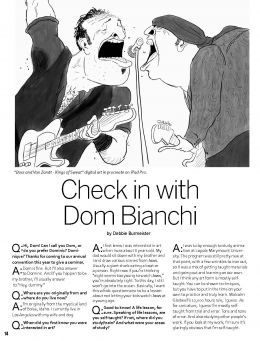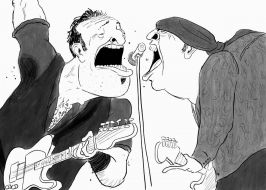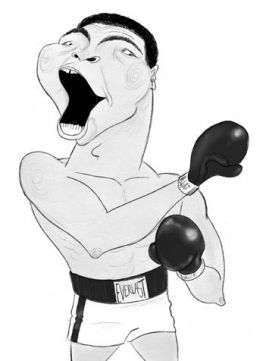Check in with Dom Bianchi
 | |
| Author | Debbie Burmeister |
|---|---|
| Subject | Dom Bianchi |
| Genre | |
| Published | EF Issue 2018.4 |
Publication date | Fall 2018.4 |
| Media type |
|
| Pages | 14-16 |
| Website |
|
Article Description. Should include author, brief description, issue number and page number(s).
Article Transcript
Q:Hi, Dom! Can I call you Dom, or do you prefer Dominic? Dominique? Thanks for coming to our annual convention this year to give a seminar.
A: Dom is fine. But I’ll also answer to Dominic. And if you happen to be my brother, I’ll usually answer to “Hey, dummy.”
Q: Where are you originally from and where do you live now?
A: I’m originally from the mystical land of Boise, Idaho. I currently live in Los Angeles with my wife and dog.
Q: When did you first know you were interested in art?
A: I first knew I was interested in art when I was about 8 years old. My dad would sit down with my brother and I and draw various scenes from Jaws. Usually a giant shark eating a boat or a person. Right now if you’re thinking “eight seems too young to watch Jaws,” you’re absolutely right. To this day, I still won’t go into the ocean. Basically, I want this whole questionnaire to be a lesson about not letting your kids watch Jaws at a young age.
Q: Good to know! A life lesson, for sure. Speaking of life lessons, are you self-taught? If not, where did you study/train? And what were your areas of study?
A: I was lucky enough to study animation at Loyola Marymount University. The program was still pretty new at that point, with a few wrinkles to iron out, so it was a mix of getting taught materials and going out and learning on our own. But I think any art form is mostly self-taught. You can be shown techniques, but you have to put in the time on your own to practice and truly learn. Malcolm Gladwell’s 10,000 hours rule, I guess. As for caricature, I guess I’m mostly self-taught from trial and error. Tons and tons of error. And also studying other people’s work. If you look at my work, I’m sure it’s glaringly obvious that I’m self-taught.
Q: I know you work for Fox Animation. What do you do there?
A: I am currently a Supervising Director on Family Guy. I’ve had that specific title for about 8 years now. But I’ve been a part of the show for about 14 years. Basically a supervising director sits around the office with a ponytail, sunglasses, and bullhorn, sips Hollywood lattes, and yells “DRAW BETTER!” all day.
Q: So is that a typical workday for you or do you have a main level of focus?
A: My job is basically to make sure that everything you see on screen is funny, clear, and is true to the style that show creator Seth MacFarlane put into place. I have to make sure that the story is visually clear, and most importantly, the jokes are presented in the funniest way they can be. It may look flat and simple, but it takes a lot of work to get it to look that way. On the animation production side, we usually have at least 15 episodes going on at the same time, all at different stages of production. Some are close to airing, some are just getting storyboarded, some are currently being animated in Korea. With all that going on at once, it’s a lot of plates to keep spinning. So we have to wear a lot of hats and focus on a lot of things at once. Right now I’m helping on timing an episode, looking at designs on another, working with our retakes department on a few others to fix animation problems, meeting with directors to figure out how to stage scenes and jokes from another episode, and meeting with the writers to go over a script that’s about to start the storyboarding process. I’m also currently working on a few grey hairs and probably an ulcer.
Q: What is your favorite animation piece you worked on and why?
A: Over the years I’ve gotten the opportunity to work on a lot of great things, but one that stands out was a carwash sequence involving Peter Griffin and Homer Simpson that I got to take the lead on. It was a parody of “sexy” carwash scenes, but with two overweight dudes in cutoff shorts (gross), all set to Def Leppard’s “Pour Some Sugar On Me”. It was a beautiful mix of disgusting and funny. I think people tend to either love it or absolutely hate it. But I had fun.
Q: Ok, I just Googled that scene you mentioned and that cannot be unseen. But you are living the dream that lots of kids have of being animators. I have heard the hours are long and with little pay, especially in the beginning. Was it a long road to get to where you are today?
A: Getting your foot in the door can be hard, and, yes, the hours can be long. But that’s usually the case for any career you’re passionate about, right? We all have to pay our dues when we start out. After college, I had a lot of strange jobs before I finally got into animation. I worked at a Hollywood Video for a while (kids, that’s like if Netflix was a real store where you would physically go and “rent” movies and loiter), and I was also the assistant to a curator of a museum of a small, strange college. It took a few years for me to get into animation, but I think that if you are really passionate about something, you have to chase it. If you have the opportunity to chase down your dream job, paying a few dues up front seems to be worth it.
Q: When did you start drawing caricatures, and what got you into the art form?
A: I just started doing caricatures within the past 2 years. I’ve always been fascinated with the art form, and it seemed to always be a real weakness of mine (probably still is). We do a lot of caricatures on Family Guy, and I always loved when they came out looking great. Our show’s style can be extremely limiting to get a good caricature — the proportions have to be within a certain boundary and so do the eye sizes, linework, etc. So I saw the beauty in being able to capture someone’s likeness with only a few simple lines. At the same time, after being on the show for over 14 years, I needed another creative outlet. So I started attempting caricatures. The goal was to draw really loose and weird, trying to get away from the Family Guy style as much as I could and trying to remember what it was like to draw for fun. Often times when artists work on one show for a very long time, they lose any sense of personal drawing style and everything they do tends to look a bit like the show they’re working on. I wanted to try to avoid that. In some cases it works, in others I’m sure people think my stuff still looks like Family Guy.
Q:Which came first, caricature or animation, and does your caricature work factor into how you make a living or do you consider it a hobby.
A: Because animation was my first love, (and it’s my full time job) I consider drawing caricatures more of a hobby. I don’t have the chops for it to be my career like some of these other amazing artists out there. Let’s just say that if I had to rely on my caricature skills to make a living, I’d be starving.
Q: Can you explain your thought process that goes into creating a caricature?
A: First off, I feel like me telling a bunch of seasoned caricaturists my process is like a caveman talking to NASA about rockets. When I create a caricature, I usually try to find something odd about a person that I haven’t seen pushed yet - an angle, a mouth shape, the way they hold their head, whatever catches my eye. Then the main goal is to capture that and create a drawing that makes people laugh. I’m slowly trying to discover my own style I guess.
Q: What mediums do you prefer to use?
A: I have been using theiPad Pro a LOT lately. The Procreate app on there is pretty awesome. The reason I have chosen this medium you ask? Laziness. And it’s insanely convenient. I tend to do a lot of my drawing on the couch, next to my wife, while we have a movie or TV show on. Preferably something that I don’t really want to watch, but I get credit for the “watch” because I’m there on the couch, but in reality I’m completely tuned out and focused on my drawing. “Sure honey, let’s watch ‘The Crown.’ ” (Please don’t let her read this!) It’s actually a nice way to draw and still spend time with my wife after long days at work. My goal is to work with more tactile medium in the future, like Copic markers and inks. I figure that since my job has me staring at a screen all day, I should probably not stare at a screen when I get home. My eyeballs are becoming raisins.
Q: Which artists have influenced you the most?
A: I’m always bad at these type of questions because I always leave the most obvious one out. But here goes: Ronald Searle, Erich Sokol, Bill Watterson, Al Hirschfeld, Gary Larson, and Chuck Jones. But also I’d have to say that a lot of my friends and co-workers are big time influences on me as well.
Q: Whose art are you following on social media these days?
A: Oh boy, I am following a LOT of incredible artists. I’m guaranteed to accidentally leave some great ones off of here, but I’ll see if I can name a few: Pete Oswald, Joe Vaux, Lindsey Olivares, Jack Perkins, Farias, Timothy Lamb, Mick Cassidy, Eric Goodwin, Nate Kapnicky, Brian Oakes, Tyler Fontes, Manny Avetisyan, Ulisses Araujo, André Carrilho, Tom Faraci, Bao Nguyen, John Bahn, Adam Ballinger, Maria Picassó i Piquer, Dan McMahan, Jorge Arévalo, Felipe Elgueta, Derek Brennan, Jason McLean, Avner Geller, Marie Thorhauge, Juaquín Aldeguer, Lindsay McMinn to name just a few...These artists are the reason my wife yells at me for spending too much time on instagram.
Q: Are you looking forward to anything in particular at the annual convention?
A: As you can see from the previous question, I follow a LOT of artists on Instagram, but I’ve never met most of them. So I can’t wait to meet them at the convention and underwhelm them in person.
Q: What do you hope people take away from your presentation this year?
A: Well, I hope they leave having learned about the animation process and the idea that artistic talents can take you into several career paths nowadays. And if I’m really boring and they fall asleep, I hope they leave feeling well rested.
Q: Where can people find more of your work?
A: People can find my work on Instagram. My handle is very creative. It’s @dombianchi.
See Also
External Links
This Navigation box may not show up on mobile browsers. Please see Exaggerated Features Issue 2018.4 for the full contents of this issue if the navigation box does not display.




